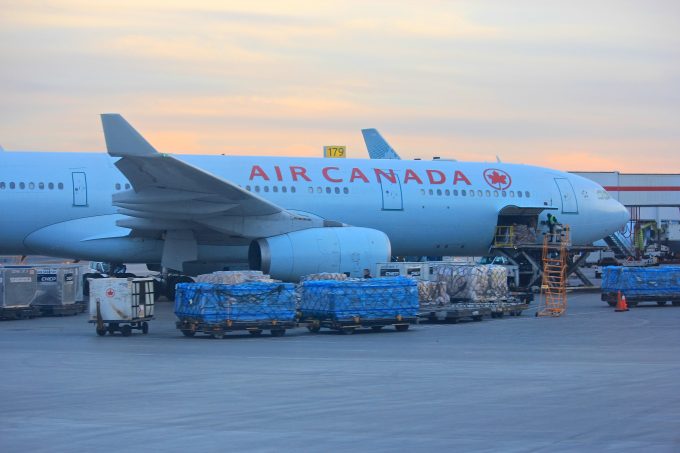Magma expands to Dubai with two freighters, as ASG keeps growing
Magma Aviation, the Avia Solutions Group-owned airline, has expanded with a new base and two ...
TFII: SOLID AS USUALMAERSK: WEAKENINGF: FALLING OFF A CLIFFAAPL: 'BOTTLENECK IN MAINLAND CHINA'AAPL: CHINA TRENDSDHL: GROWTH CAPEXR: ANOTHER SOLID DELIVERYMFT: HERE COMES THE FALLDSV: LOOK AT SCHENKER PERFORMANCEUPS: A WAVE OF DOWNGRADES DSV: BARGAIN BINKNX: EARNINGS OUTODFL: RISING AND FALLING AND THEN RISING
TFII: SOLID AS USUALMAERSK: WEAKENINGF: FALLING OFF A CLIFFAAPL: 'BOTTLENECK IN MAINLAND CHINA'AAPL: CHINA TRENDSDHL: GROWTH CAPEXR: ANOTHER SOLID DELIVERYMFT: HERE COMES THE FALLDSV: LOOK AT SCHENKER PERFORMANCEUPS: A WAVE OF DOWNGRADES DSV: BARGAIN BINKNX: EARNINGS OUTODFL: RISING AND FALLING AND THEN RISING

Air Canada (AC) was the first airline to remove seats and deploy passenger aircraft as freighters back in April, when Covid-19 lockdowns grounded fleets.
Now the airline is preparing to turn 767s into permanent freighters to establish main deck capacity as a long-term strategic plank in its operation.
AC has been a prolific user of ‘preighters’: since the spring it has been operating three B777-300s and four A330-300s without seats for cargo missions, and clocked up more than 3,000 such flights. During the fourth quarter, it plans about 100 cargo flights a week.
Vito Cerone, MD cargo sales and commercial strategy, said the cargo division could deploy more passenger planes for cargo missions if required, but the airline had no intention of taking seats out of more passenger aircraft.
While ‘preighters’ have played an important role in moving cargo and will likely be needed to move the Covid-19 vaccine, operators have pointed out that the operating economics are not very impressive. Avianca suspended the use of passenger aircraft flights for cargo missions once yields retreated from their plateau reached in April/May.
However, as the prospect of passenger numbers returning to pre-pandemic levels recedes, AC’s management finds itself with parked aircraft that can perform better than ‘preighters’: the airline has a fleet of 30 767-300ERs that are idle at this point.
“They’ve been parked, so why not convert them and operate them as freighters?’ Mr Cerone said.
In the second quarter, AC cargo revenue exceeded that from the passenger business for the first time, and in the third quarter, reached C$216m (US$166.2m), up 22% year on year, while overall revenues were down 86%, resulting in a C$685m loss.
Announcing the Q3 results, CEO Calin Rovinescu, who will step down at the end of the year, unveiled the plans for freighter operations, adding: “Cargo will become an increasingly important part of our business as we plan to expand to dedicated freighter business.”
With belly capacity and passenger revenue expected to take two to three years to recover, the contribution from cargo will remain disproportionately high for some time, but the freighter strategy is aiming beyond the near term, said Mr Cerone.
Canada is not a strong origin-and-destination market that needs freighters (although Canadian forwarders have lamented lack of main deck lift), but AC’s global network, which has grown significantly in recent years, makes all-cargo planes viable, he said.
Management has not yet determined specific routes for freighter flights, but they would not differ dramatically from the freighter venture AC had with all-cargo airline Cargojet until the end of 2017, when Cargojet operated 767F flights to Frankfurt, Colombia and Peru with the lift marketed by AC.
Demand to link Latin America with Europe and Asia have been strong, making this a promising arena for a freighter venture, Mr Cerone said.
Opposition from AC’s pilots was cited as one reason for the termination of the AC-Cargojet venture and to meet its new freighter ambitions, the airline requires the blessing of its pilot union. But Mr Cerone does not anticipate any serious conflict.
“This is different from the situation with Cargojet,” he said. “I don’t see this as a big hurdle.”
AC intends to start the freighter operation with two 767s. Down the road, this could rise to about to six planes, Mr Cerone reckons.
Assuming that the road to take-off is smooth, he hopes this can become established before the fourth quarter of next year.
Comment on this article
Rayhan ahmed
November 13, 2020 at 3:15 pmI have just loaded a air Canada Boeing 777
300 and there was plenty of cargo in
The belly hold . It could be that air Canada
Cargo capacity is high we’re they were the
First airline alongside ElAL to turn 777 s
Into preighters .